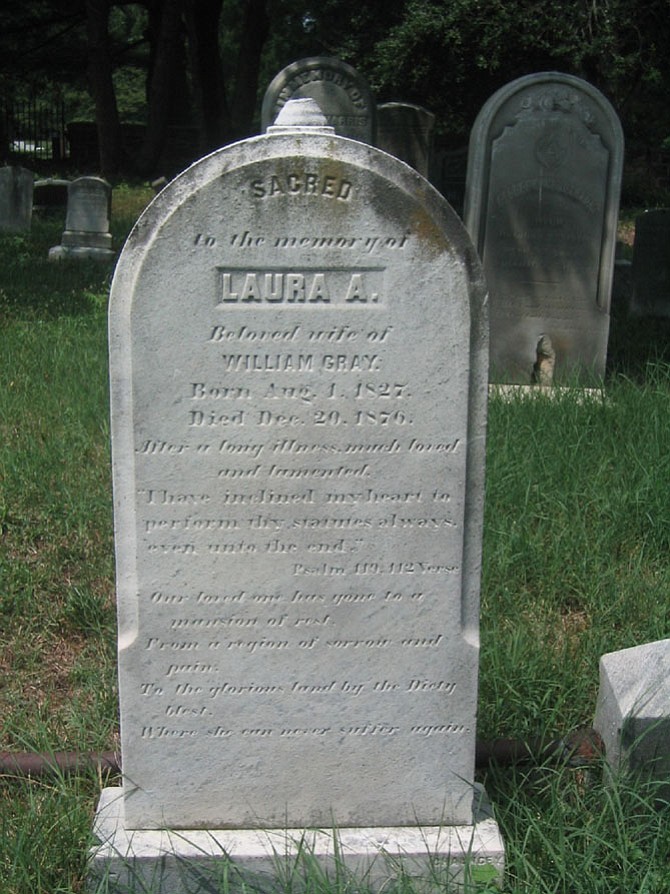This picture was taken at the Methodist Protestant Cemetery on Wilkes Street. The headstone is of Laura A. Gray – 1827-1876.
One of the earliest Decoration (Memorial) Day commemoration celebrations was at the end of the Civil War. Many freed slaves, United States Colored Troops and Union soldiers came together to properly bury their dead by establishing Union cemeteries. These individuals sang hymns, had public readings and distributed flowers around the cemetery.
In 1868, General John A. Logan, the commander-in-chief of the Union veterans’ group known as the Grand Army of the Republic declared May 30 as a nationwide day to commemorate soldiers killed in the Civil War. Logan believed that Americans should lay flowers and decorate the graves of the war dead. During the World Wars, Decoration Day Celebrations were broadened to include all veterans who have died.
For about a century, May 30 was known as Decoration Day until the Uniform Monday Holiday Act of 1968 went into effect declaring the traditional observance celebration as Memorial Day, moving the time from May 30 to the last Monday of May. By 1971, the Federal Government made Memorial Day a National Holiday.
A former Alexandrian, Perry Winslow remembered, “Memorial Day was called Decoration Day when I was young. That’s the way it was written on the calendar. The ‘funeral home calendars’ of the day which had a wreath icon for May 30 with the words ‘Decoration Day’ written under it.”
A non-African American shared her Memorial Day tradition, Linda Bolton stated, “Every holiday and in between we would walk to Bethel Cemetery and place flowers on many relatives’ graves. Then visit the cemetery and beyond to visit my great-grandparents.” Her great-grandmother came from Germany in 1854.
Mrs. Carolyn Phillips-McCrae’s family has been in Alexandria for over 200 years, she said, “On Memorial Day going to Bethel and Douglass cemeteries, it was an outing for older folks. Family and friends would meet and talk about old times. Children would come along and hear older folks discussing who were related to whom. My mother would discuss areas where she thought certain folks were buried but did not know for sure, especially if the site did not have a marker …”
For many of us, Memorial Day is a special day. My own family was similar to Mrs. McCrae, my great-grandmother’s cousin celebrated Memorial Day with her siblings by visiting the cemetery where her mother was buried. In my great cousin’s late 80s, I remembered her and her siblings going to the cemetery with their quilts, picnic lunches, and their brown bag drinks. They would have their grandchildren clean the graves and place flowers on our relatives’ graves. Then their grandchildren would leave them there for the rest of the day. My great-cousin, Sygnora, and her siblings would eat, reminisce, laugh and make a toast to their mother and every relative buried at the cemetery. They would reminisce about their childhood and cry over the ones that died too young. Somehow, I believe it was more toasting instead of eating. By the end of the day, neither of the old women could walk back to the car. Their grandchildren were used to these Memorial Day ceremonies, so they would bring a wheelchair to get them back to the car. This Memorial Day tradition was a practice that they had been doing all their lives, a tradition that has been passed down from one generation to the next. They all are gone now, but the memories of my family Memorial Day celebration make me smile.
I am sure on Memorial Day you too will have fond memories of your family traditions. Happy Memorial Day.
Char McCargo Bah is a freelance writer, independent historian, genealogist and a Living Legend of Alexandria. See her blog at http://www.theotheralexandria.com for more about “The Other Alexandria.”
More like this story
- The Other Alexandria: From West Virginia to Alexandria – Click Family of Bethel Cemetery
- Identifying Descendants of Civil War-era Freed Slaves
- The Other Alexandria: Coming Home to Old Alexandria
- Putting the Spotlight on City’s African American History
- The Other Alexandria: He Never Came Back Home: Private William Thomas
